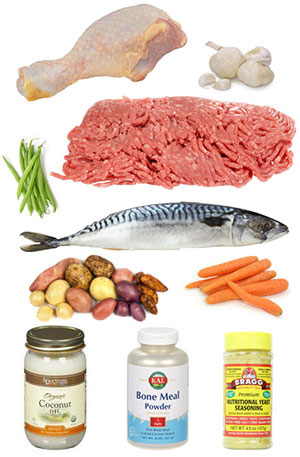Home-Cooked Diet
 Making a home-cooked diet for your furry friend is not as time consuming as you may think. If you prepare the food in bulk to last several days, then it becomes a very easy process.
Making a home-cooked diet for your furry friend is not as time consuming as you may think. If you prepare the food in bulk to last several days, then it becomes a very easy process.
Since every major pet food brand has been involved in food recalls, some very serious that resulted in the sickness and death of thousands of pets throughout the US, more and more pet owners are opting for home-cooked foods and home-baked treats. Not only are they healthier and fresher, but when you calculate the cost, it ends up being comparable to many of the expensive brands including "veterinary diets" (some of which contain absolutely terrible ingredients!).
The following basic recipe is based on (though not identical to) Dr. Pitcairn's Complete Guide to Natural Health for Dogs & Cats,(1) which I highly recommend to any pet owner.
- 60% meat (or fish - especially oily fish such as sardines or mackerel)
- 20% sweet potato, yams, or brown rice
- 20% mixed vegetables
- 1 tablespoon unrefined/cold pressed coconut or olive oil
- 1 tablespoon bone meal
- 1 tablespoon nutritional yeast
- 1 clove garlic
- Sprinkling of sea salt
Don't Be Afraid Of Garlic!
Some people are confused about using garlic in their pet food because of incorrect information or distorted facts on the subject sprinkled around the internet, whereas others use it in large quantities because it is recommended by their vets. I have yet to meet a Naturopathic vet that does not recommend garlic in pet food! Despite what you may have read on some websites, garlic is NOT "dangerous" or "toxic" for dogs at all, unless you pup has a specific issue or disease that would contraindicate garlic. I have lost count of the number of times I have seen the statement "oh, don't feed your dog garlic, it's bad for them..." based on someone repeating incorrect information. When I have asked these websites to provide their "sources," they simply quote other websites, who again quote other websites.
Dr. Pitcairn is a widely respected veterinarian and author who specializes in natural health for pets, and his daily garlic recommendations are as follows:
10-15 pounds: 0.5 clove
20-40 pounds: 1 clove
45-70 pounds: 2 cloves
75-90 pounds: 2.5 cloves
100 pounds+: 3 cloves
What are the benefits of feeding your pooch garlic? Well, there are some great ones!
- Tick/Flea Repellent: We have been feeding our pets garlic for years and never have to use flea and tick medication. It does not kill the pests, but they tend to avoid dogs who eat garlic. If you live in an area that is infested with either fleas or ticks, however, garlic will likely not be strong enough.
- Bacterial, Viral, and Fungal Protectant: With its potent antimicrobial and antibiotic properties, garlic fights internal parasites and protozoan organisms. It also helps make the digestive tract inhospitable to giardia.
- Boosts Immune System: Garlic is a great addition for pets who have suppressed immune system function, as well as those fighting chronic diseases. It also helps to detoxify the body of toxins.
- Cardiovascular Protectant: Garlic can help prevent blood clots, and reduce cholesterol and fat build up in the arteries.
Helpful Meal Preparation Tips
- Prepare In 3-day batches
Work the food preparation into your schedule and cook enough food to last 3 days. I cook everything at the same time and it takes me no longer than 30 mins to cook it, mash it up, and put in containers in the fridge. Meat is cooking in one pan, chopped up sweet potatoes are boiling in another, while veggies are simmering in another. I store the water I use to simmer the veggies and mix it in with the food because it is full of the minerals and nutrients that have been leached from the veggies during cooking. Avoid using the microwave, and here's why. - Avoid factory-farmed (feedlot) meat
There is nothing healthy about factory-farmed meat, either for yourself, or for your pet. If the meat you purchase is not organic, or labeled as pasture-raised/grass-fed, then it is factory-farmed. This meat has been pumped with antibiotics, growth hormones, steroids, and fed an unnatural and genetically modified diet of GM soy or corn. It is a contributing factor to the skyrocketing rates of allergies, antibiotic resistance, and chronic diseases in both pets and humans. It is also a cruel and inhumane practice that is banned in other countries.
- Why you should never buy factory-farmed meat
- The health consequences of eating factory-farmed meat
- How to make responsible meat purchasing decisions
Check out your local farmers market (or farms) for any deals on local meats. Our local store sells pasture-raised rotisserie chickens for $5.99 - it only takes me about 10 mins to remove all the meat and organs, chop it up, and store it in the fridge to last 3 days. My pup goes crazy for it, and it saves me some cooking! - Look for what's on sale & mix it up
Organic ground beef that is not lean (70-80% lean) is much cheaper than its leaner counterpart, and more appropriate for your pup. See what deals they have in the meat and fish section. There are often great deals on meat sold on or near to the sell-by date that can make organic meat just as cheap as its non-organic counterpart. If you choose fish, watch out for the pieces that have bones. Canned sardines and anchovies add great variety - just watch out for any additional ingredients that you pet does not need. They should be canned in either water or oil, with nothing else. - Use a high quality coconut or olive oil
Look for the cold pressed, unrefined version that has been minimally processed. We personally use coconut oil because our pup goes crazy for it. - Bone meal Is important
The calcium and other ingredients in bone meal are essential for your pet's health. Do not forget to include it with their meals, as well as feeding raw bones on a regular basis. - Consider making bone broth
Bone broth is easy to make in large batches that can be refrigerated, with the excess frozen. It is full of nutrients from the simmering bones and veggies, and gives a wonderful burst of taste and flavor to your pup's meal.
A Word About Plastic Containers & Cans
Make sure the plastic containers you buy to store the food in are BPA-free. Look for the BPA-free label on the bottom of the container, or on the product packaging label. The same goes for any canned foods you purchase (such as canned sardines). BPA is a toxic chemical that has been linked to some serious disorders and has no place in the packaging of human or pet foods.
Home-Baked Treats
Baking your own doggy treats couldn't be easier. With just a few ingredients from your local store, you can whip up your own fresh and healthy treats and not have to worry about pet treat recalls and unhealthy ingredients.
Home-baked doggy treat recipes...
RELATED ARTICLES
- Why pets are getting sicker
- Healthy & balanced pet diet
- Tips on choosing a healthy pet food
- Home cooked diet
- Raw food diet for pets
- Doing raw right for pets
- Home-baked doggy treats
- Bones - nature's toothbrush
- Bone broth recipe
- Pet food recalls
- Treating common pet injuries
- Pet-proofing your home
- Preparing for a new pet!
- Fleas, ticks, & mosquitoes
- Natural dog grooming
- Pet dental care
- Pet vaccinations
- Declawing



